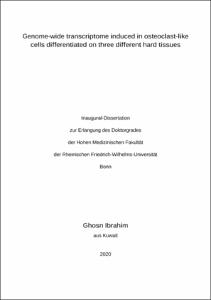Ibrahim, Ghosn: Genome-wide transcriptome induced in osteoclast-like cells differentiated on three different hard tissues. - Bonn, 2020. - Dissertation, Rheinische Friedrich-Wilhelms-Universität Bonn.
Online-Ausgabe in bonndoc: https://nbn-resolving.org/urn:nbn:de:hbz:5-58038
Online-Ausgabe in bonndoc: https://nbn-resolving.org/urn:nbn:de:hbz:5-58038
@phdthesis{handle:20.500.11811/8360,
urn: https://nbn-resolving.org/urn:nbn:de:hbz:5-58038,
author = {{Ghosn Ibrahim}},
title = {Genome-wide transcriptome induced in osteoclast-like cells differentiated on three different hard tissues},
school = {Rheinische Friedrich-Wilhelms-Universität Bonn},
year = 2020,
month = may,
note = {Hard tissue resorption is a multistep process, which requires a complex interaction between multinucleated clast cells and the hard tissues to be resorbed. This process is regulated by genetic factors and inflammatory cytokines. This study was directed toward the clast cells to clarify the ability of these cells to distinguish between the resorbed substrates and the possible influence of the resorbed tissues on the intracellular mechanism behind the resorption process. To study the influence of the mineralized tissues on the differentiation and activity of the clast cells, macrophage cells were cultured on powder substrates made from bone, dentine and cementum tissues. After cell differentiation, ribonucleic acid was isolated and gene expression induced by the three hard tissues was analyzed based on RNA-Sequencing. The results showed many differentially expressed gene between the samples of the study.1930 genes were significantly differentially regulated on cementum compared with the cells stimulated on glass, 446 between bone tissue and the positive control 87 between dentin and control samples. Moreover, the comparison between the stimulated cells on the hard tissues showed 314 differentially regulated genes between cementum and dentine, 252 between bone and cementum and just one significantly differentially regulated gene between dentine and bone. These results reflect the influence of the hard substrates on the differentiation and activity of osteoclast-like cells. For example, cathepsin k gene was downregulated by 3.2 folds in the bone samples and in the cementum samples by 4.8 folds compared to the cells differentiated on glass but in the dentin groups there wasn’t any significant difference in gene expression. Comparing bone and dentine samples it was upregulated by 3.8 folds in the dentine samples and was downregulated by 1.5 folds in the cementum samples when compared with bone samples. In the comparison between cementum and dentin samples cathepsin k was upregulated in dentine samples by 11.3 folds. Some possible candidates were identified like Inhibitor of differentiation1 gene which was upregulated only in cementum samples in comparison with cells differentiated on glass and upregulated by 3.5 folds in cementum samples compared with bone samples. In comparison with dentin this gene was downregulated in dentin samples by 2.7 folds and didn´t show any significant change between bone and dentin samples. The present study expands our understanding of the interaction between clast cells and mineralized tissues and indicates new possible target genes of relevance for diagnostic and therapeutic strategies.},
url = {https://hdl.handle.net/20.500.11811/8360}
}
urn: https://nbn-resolving.org/urn:nbn:de:hbz:5-58038,
author = {{Ghosn Ibrahim}},
title = {Genome-wide transcriptome induced in osteoclast-like cells differentiated on three different hard tissues},
school = {Rheinische Friedrich-Wilhelms-Universität Bonn},
year = 2020,
month = may,
note = {Hard tissue resorption is a multistep process, which requires a complex interaction between multinucleated clast cells and the hard tissues to be resorbed. This process is regulated by genetic factors and inflammatory cytokines. This study was directed toward the clast cells to clarify the ability of these cells to distinguish between the resorbed substrates and the possible influence of the resorbed tissues on the intracellular mechanism behind the resorption process. To study the influence of the mineralized tissues on the differentiation and activity of the clast cells, macrophage cells were cultured on powder substrates made from bone, dentine and cementum tissues. After cell differentiation, ribonucleic acid was isolated and gene expression induced by the three hard tissues was analyzed based on RNA-Sequencing. The results showed many differentially expressed gene between the samples of the study.1930 genes were significantly differentially regulated on cementum compared with the cells stimulated on glass, 446 between bone tissue and the positive control 87 between dentin and control samples. Moreover, the comparison between the stimulated cells on the hard tissues showed 314 differentially regulated genes between cementum and dentine, 252 between bone and cementum and just one significantly differentially regulated gene between dentine and bone. These results reflect the influence of the hard substrates on the differentiation and activity of osteoclast-like cells. For example, cathepsin k gene was downregulated by 3.2 folds in the bone samples and in the cementum samples by 4.8 folds compared to the cells differentiated on glass but in the dentin groups there wasn’t any significant difference in gene expression. Comparing bone and dentine samples it was upregulated by 3.8 folds in the dentine samples and was downregulated by 1.5 folds in the cementum samples when compared with bone samples. In the comparison between cementum and dentin samples cathepsin k was upregulated in dentine samples by 11.3 folds. Some possible candidates were identified like Inhibitor of differentiation1 gene which was upregulated only in cementum samples in comparison with cells differentiated on glass and upregulated by 3.5 folds in cementum samples compared with bone samples. In comparison with dentin this gene was downregulated in dentin samples by 2.7 folds and didn´t show any significant change between bone and dentin samples. The present study expands our understanding of the interaction between clast cells and mineralized tissues and indicates new possible target genes of relevance for diagnostic and therapeutic strategies.},
url = {https://hdl.handle.net/20.500.11811/8360}
}






